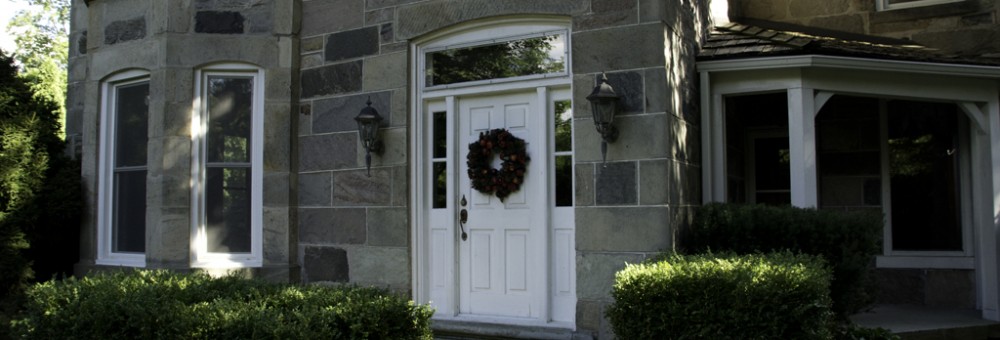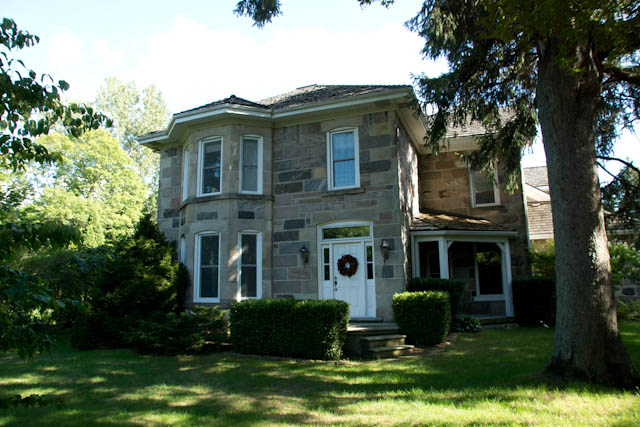Today, we had the house inspection. I had no idea what to expect, having never actually experienced one of these in the past. The only other time we have bought a house, we had already lived in it for four years, so we had a pretty good idea of what we were getting in to. Then we built a house, so for that we knew EXACTLY what we were getting into.
This was different. Actually, this was extremely different. This time, we were buying a house that, as near as we could tell, was constructed before Canada was a country. Rather than a house built expressly to our wants, we were buying a house designed to the tastes of someone that hasn’t been walking the planet for a good long while now.
Despite getting home from the airport at midnight the night before, I managed to get myself out to the house early. Really early. An hour early. I left Toronto at 6:45, and I wound up being in Woodstock by 8:00am (mostly because there was absolutely no point going to Innerkip at that time; Innerkip is pretty sparse in terms of services at the best of times, and at 8:00am on a weekday there is pretty much nothing happening at all).
Everyone converged on the house at a few minutes before 9:00am, and we got down to business relatively quickly. Graham, the home inspector, indicated that he figured about 5 hours would be required for the inspection, which would turn out to be a pretty accurate estimate. Joan, the real estate agent, resigned herself to five hours of what could be described as the functional equivalent of watching paint dry. (In her view, the only thing less exciting than inspection day is the day she gets to watch them pump the septic tank).
We started with an overall tour of the exterior of the building. Given that we had managed to pick a rainy day (which, in the final analysis is not actually a bad thing – if nothing else, it helps to find the leaks) this was a fairly damp tour of the perimeter. During it, we discovered many things. For starters, the masonry of the house is of exceptionally high quality. And cedar shakes look fabulous, but aren’t necessarily the most awesome thing to sheath your roof inn. Also, apparently air conditioning units have a life expectancy of about 15 years (which meant the 22 year old example here qualified for pensionable service). And apparently there are such things as carpenter bees, and they’ve decided that two of the boards in our house make for a fine residence.
So starting out, we had some cautions. None were show-stoppers, particularly, but they were useful illustrations that: a) we’re moving to the country; b) the country has wildlife; and c) there is no such thing as a perfect home, there is simply a question of how much imperfection you are prepared to deal with.
Moving inside, we then got to check out the attic spaces, for there is indeed an attic in the old part of the house. An attic which, apparently, was at some point visited by bats. Actually, it was at some point apparently inhabited by bats, given the relative accumulation of guano (more than a one night stand, but not so much that they could be accused of co-dependency or squatting). There were no real signs of bats today, but that’s not to say that they weren’t there. Although any presence has been limited to the attic space, and they have yet to be sighted anywhere else in the house.
The longest time during the inspection was spent in the basement, which is home to most of the mechanical systems. The electrical panel is, for the age of the house, in surprisingly good order – it is virtually brand new. The plumbing is incredibly well designed. One furnace is brand new, while the other is near the end of its useful life and we have a water heater that is perilously close to giving up the ghost. And given that there is also a crack in the exhaust piping, we’re going to have to give the water heater last rites and move on. With luck, this is more a problem of plumbing and less a need for an exorcism.
The rest of the inspection went reasonably well. There are some plumbing leaks in bathrooms that are being renovated anyway, there are a couple of windows that are bafflingly original given that most of the rest of the windows have been replaced. There is also a half door in the dining room in place of wainscotting on one wall. And to be clear, it is literally a half-door; above it (and behind it) there is wall. The door is surreptitiously hidden behind a sideboard at present, and I imagine we will be employing a very similar strategy going forward.
The only other major issues are a minor infestation of knob-and-tube wiring in the dining room, and a major infestation of raccoons in the garage. The knob-and-tube wiring should be manageable without repair. The raccoon infestation, however, will be another problem. Given the damage to drywall, the apparent shifting of insulation and the redolent bouquet of eau-de-vermin, there is going to need to be some fairly extensive work done in the garage much earlier than we intended. Namely, the replacement of about 1,000 square feet of drywall, insulation and vapour barrier on the garage ceiling. The nice thing, of course, is that we have a 1,000 square foot garage; the downside is that it makes for a lot of ceiling to be replacing. I think we just found our first major change request on the renovation.
Overall, the inspection was incredibly worthwhile, and eye-opening into the bargain. I have a much better idea of what we are getting in to, while at the same time being reassured about the state of repair of our new home. We are buying a house that was of above-average quality 150 years ago, had an above-average quality addition some 17 years ago, and has for the most part been maintained and upgraded with care and attention in the intervening years.
Without question, we are indebted to our inspector – Graham Lobban of Lobban Stroud – for an amazing job of going through the house. His attention to detail was impressive, and his understanding of what we were dealing with was exceptional. He did a great job of giving an honest assessment of the condition of various aspects of the house, without being alarmist. There was no building code 150 years ago, so expecting compliance to the code of today is a fantasy. Knowing the quality of what is there relative to what should be expected from a house of this age, however, is a pragmatic necessity.
We now have that, and more; we also have a guide to what will be necessary to maintain the house in its current condition in the years to come. Boo Manor is about to become a reality.



